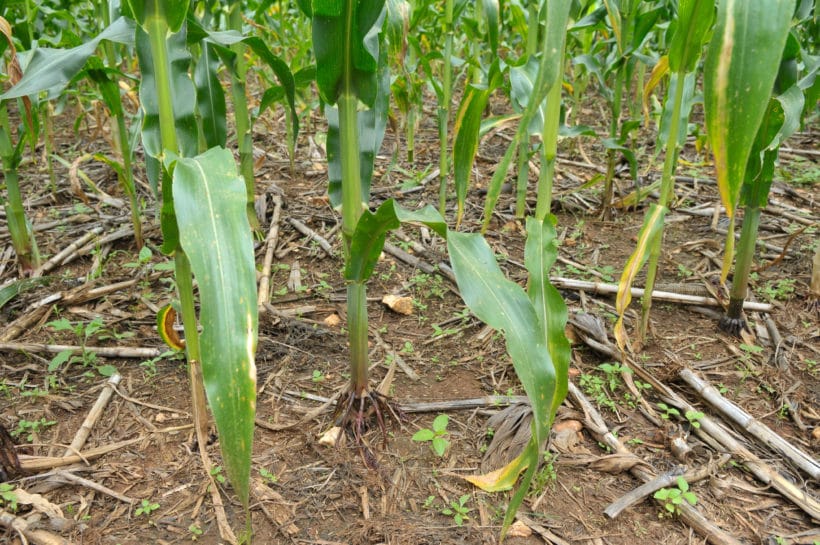
Photo: via Flickr
With more than a million people facing hunger, the famine in southern Madagascar this year was driven largely by climate change.
And yet research shows that this will only be one of many around the world to be directly linked to higher temperatures, with up to 600 million people to become undernourished by 2050 if warming exceeds 2°C.
Many of the world’s more than 500 million smallholder farmers, especially across developing regions, are already struggling to adapt to these dramatic changes that will only worsen as warming continues.
Millions of smallholder farmers lack access to improved crops that have been increasingly bred to tolerate conditions like heat, droughts, floods, and less predictable rainfall.
If more widely adopted, these higher-quality and more resilient varieties would increase food security for millions of families, particularly those in more climate-vulnerable regions.
Yet, breeding climate-resilient crop varieties alone is only part of the solution. Development partners must also help to build or support networks that ensure improved seeds reach farmers who need them by making them available, affordable, and accessible.
Estimates suggest that an investment of USD$20 million per year in these ‘seed systems’, would not only increase the supply of much-needed high-quality seeds by 50 percent in six targeted climate-vulnerable countries, but would also create tens of thousands of jobs in seed and related businesses, including for women and young people.
And to most effectively prepare for the impact of climate change, this investment must be directed towards those varieties and crops we know can withstand the increasingly unpredictable changes we are seeing around the world.
Cassava, for instance, is a hardy staple root crop across Africa that is vital to both food and economic security for the poorest smallholders, and yet yield in countries like Nigeria has remained low, at less than 10 tons per hectare, for a lack of quality seed material.
Traditional agro-dealers rarely sell planting material and free distributions by government agencies or partners can be unreliable, leaving some of the most resource-poor farmers without the means of producing food.
But by investing in and establishing seed enterprises that sell high-yielding cassava stems, it is possible to create a pipeline of quality and resilient planting material that is accessible to farmers who most need it.
Such an approach, led by the CGIAR’s International Institute of Tropical Agriculture (IITA), has shown success in Nigeria, where 150 such enterprises were launched to produce cassava seeds certified by government agencies.
A similar approach is being used in Tanzania, where more than 600 cassava seed entrepreneurs have established successful small-scale businesses selling certified seed of high-yielding disease-resistant varieties. This is helping to tackle the devastating cassava brown streak virus disease whose effects have been exacerbated by climate change impacts.
Meanwhile, investing in seed development can also make a positive difference for the incomes of many of the world’s most vulnerable farmers. For example, in the aftermath of a maize harvest failure in western Kenya in 2012, a US$1 million investment in seed production of an improved bean variety led to more than US$3 million in revenues within just three years, and allowed nearly 170,000 farmers in the region access to higher-performing and more resilient seeds.
However, to ensure investments in climate-smart varieties are successful, scientists developing those varieties need to understand exactly which traits and characteristics farmers and consumers need, so that seeds can match farmers food needs as well as market demand.
Furthermore, farmers currently upgrade the crop varieties they grow on average once every 14 years. But if we are to meet the pressing demands of climate change and hunger, new business models are needed to cut this timeframe to at least once every decade, helping farmers to produce more efficient and resilient crops, sooner.
Finally, many farmers are wary of adopting new crop varieties given each planting season may be their only opportunity in a year to earn enough to feed their families and send their children to school. Research shows that better seeds can bring a return on investment, but we urgently need to help farmers minimize the risks and support them in making these upgrades for the better.
Ultimately, investment from the public and private sectors will help farmers secure new, more productive, and more resilient planting materials in a lower risk environment. This investment will be crucial if we are to address the world’s dual hunger and climate crisis.
With the demands of climate change and a growing population here to stay, investment in better seeds for farmers is a fast-track path we can take to climate-proofing our future food systems.
Ian Barker, PhD, Program Director, CGIAR International Potato Center
James Legg, PhD, plant virologist, CGIAR International Institute of Tropical Agriculture